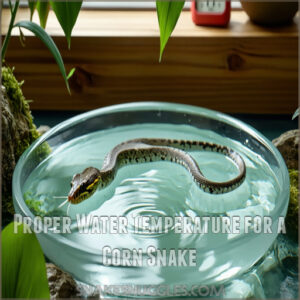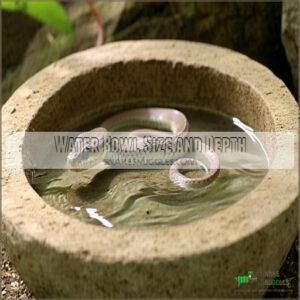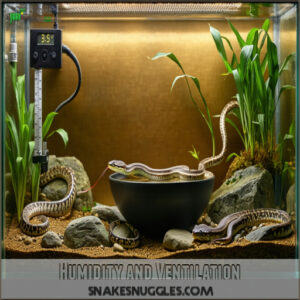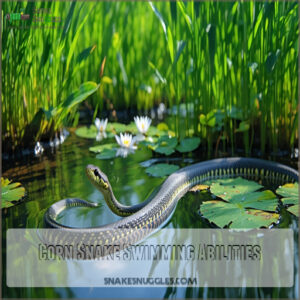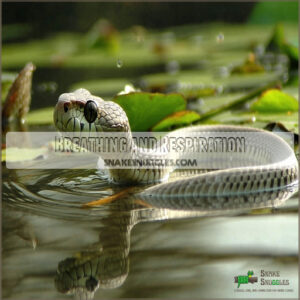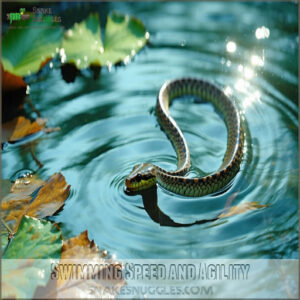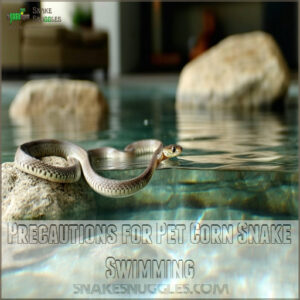This site is supported by our readers. We may earn a commission, at no cost to you, if you purchase through links.
 Yes, corn snakes can go in water, and they’re actually great swimmers.
Yes, corn snakes can go in water, and they’re actually great swimmers.
Water is super important for their health—it helps with hydration, shedding, and even keeps their skin in good shape.
If you’re letting your corn snake swim, make sure the water is shallow and warm (around 75-85°F) to keep them comfy and stress-free.
A large, shallow bowl works great for soaking, and you should always supervise them during water time.
Swimming or soaking also gives them exercise and mental stimulation.
Just remember, don’t force it if they’re not into it—some snakes like water, but others prefer to stay dry!
Table Of Contents
- Key Takeaways
- Can Corn Snakes Go in Water?
- Why Do Corn Snakes Need Water?
- How to Provide Water for Corn Snakes
- Can Corn Snakes Swim?
- Benefits of Swimming for Corn Snakes
- Precautions for Pet Corn Snake Swimming
- Frequently Asked Questions (FAQs)
- Can I put my corn snake in water?
- Is it normal for my corn snake to sit in water?
- How long can snakes stay in water?
- Can you put snakes in water?
- Can you put a corn snake in water?
- Why is my corn snake soaking in water?
- How long can snakes go underwater?
- Do corn snakes like wet?
- How often should I bathe my corn snake?
- Can corn snakes be left to swim unsupervised?
- Conclusion
Key Takeaways
- Keep the water shallow and warm (75-85°F) to ensure your corn snake’s safety and comfort during swimming or soaking.
- Supervise your snake at all times during water sessions to prevent stress, exhaustion, or accidents.
- Soaking can help with shedding, hydration, and even skin health, but don’t push your snake if it’s uncomfortable with water.
- Always make sure the water is clean and non-chlorinated, and provide a safe and easy way for your snake to exit.
Can Corn Snakes Go in Water?
Wondering if your corn snake can take a dip? These fascinating reptiles aren’t just land lovers – they’re surprisingly capable swimmers who can navigate water with impressive ease and agility.
Snake Baths: The Lowdown
Bathtime for your slithery friend isn’t just a splash—it’s a vital care routine.
Here’s what you need to know about snake baths and corn snake water quality:
- Tepid water (75-85°F) prevents shock
- Use shallow dishes for safe soaking
- Clean filtered or spring water only
- Keep bathing sessions around 15 minutes
Corn snakes are surprisingly adept swimmers, so providing a suitable aquatic environment can be enriching.
Snake hygiene matters: gentle water exposure helps with shedding and keeps your scaly companion healthy and happy.
Snake Swimming: Fact or Fiction?
Ever wondered if snakes can actually swim?
Corn snakes might surprise you with their aquatic skills!
They’re not just land lovers – these slithery friends can navigate water like pros.
Check out how these reptilian athletes handle their unexpected swimming talents:
| Skill | Performance |
|---|---|
| Water Adaptation | Excellent |
| Swimming Speed | Impressive |
| Natural Instinct | Surprising |
This showcases their ability to adapt, making them quite the reptilian athletes.
Importance of Water for Snakes
Because water plays a vital role in a corn snake’s life, understanding its importance can help you become a better pet owner.
Water isn’t just a drink—it’s a lifeline for your scaly friend.
- Soothes skin during shedding like a mini spa treatment
- Helps regulate body temperature with natural cooling tricks
- Provides mental and physical exercise through gentle movement
- Creates opportunities for bonding and trust-building
- Acts as a natural cleaning mechanism for your snake’s health
Proper hydration keeps your corn snake thriving, happy, and ready for adventure.
Why Do Corn Snakes Need Water?
If you’ve got a corn snake, you’ll want to understand why water is essential for their well-being.
These fascinating reptiles need water not just for drinking, but for shedding, temperature regulation, and overall health maintenance.
Shedding and Hydration
Right along the path of snake care, maintaining water balance is essential for your corn snake’s skin health during shedding.
A gentle soak softens old skin, helping your slithery friend slip out of its worn-out coat like a perfectly custom-made snake suit.
These hydration methods prevent shedding complications and keep your reptilian buddy comfortable and clean.
Temperature Regulation
Just wrapped up helping your corn snake shed its skin? Now let’s explore how they cool down and stay comfy through temperature regulation.
Snakes don’t sweat like humans, so they rely on external sources to manage body heat. Creating a proper temperature gradient is crucial for their well-being.
Here’s how they do it:
- Seek cool water for quick temperature drops
- Move between warm and cool zones in their habitat
- Use water bowls as personal cooling stations
- Adjust their position to maintain ideal body temperature
Your corn snake’s water bowl isn’t just for drinking – it’s a sophisticated thermoregulation tool.
By providing a spacious bowl in a carefully managed habitat with consistent thermal gradients, you’ll help your slithery friend stay perfectly balanced and stress-free.
Enrichment and Exercise
Your scaly friend craves more than just basic survival – they need mental stimulation.
Snake Agility comes alive through Water Play, giving corn snakes a chance to explore and stretch their muscles.
Environmental Enrichment isn’t just a fancy term; it’s about keeping your reptile engaged, active, and happy.
A water bowl isn’t just hydration – it’s a mini-adventure playground for your curious companion.
How to Provide Water for Corn Snakes
When setting up a water environment for your corn snake, you’ll want to create a safe space that mimics their natural habitat.
Your snake’s water bowl should be large enough for soaking, shallow enough for easy exit, and maintained at a consistent temperature between 75-85°F to guarantee their comfort and well-being.
Proper Water Temperature for a Corn Snake
One key to keeping your corn snake happy? Nailing the perfect water temperature.
Here’s your go-to guide for snake hydration success:
- Aim for 75–85°F during daytime hours
- Allow a gentle temperature drop to 60–70°F at night
- Invest in a reliable digital thermometer
- Monitor temperature consistently for thermal regulation
Maintaining the right optimal temperature ranges is essential for your snake’s health and well-being.
Your snake will thank you for creating a comfortable, safe aquatic environment.
Water Bowl Size and Depth
After nailing the perfect water temperature, it’s time to tackle your corn snake’s water bowl setup.
Size matters – your slithery friend needs room to soak without feeling squished.
The water bowl should let your snake stretch out comfortably, but not so deep they struggle to surface.
Choosing the right shallow water bowls is essential for your corn snake’s comfort and safety.
The key is to find a bowl that meets specific criteria to ensure your snake’s well-being.
| Bowl Criteria | Recommended Specs |
|---|---|
| Depth | 1-2 inches |
| Size | Fits full snake length |
| Material | Ceramic or sturdy non-slip |
Keep it shallow, secure, and just right.
Humidity and Ventilation
After sizing up that perfect water bowl, let’s talk air quality and moisture.
Your corn snake’s home needs smart humidity control between 50-60%.
Use a hygrometer to track moisture levels, and make certain good ventilation to prevent respiratory risks.
Mist occasionally, use a humidity box, and watch for healthy shedding – it’s your snake’s secret health indicator.
To achieve ideal humidity levels, invest in a hygrometer device for accurate measurements.
- Breathe easy with proper airflow
- Monitor moisture like a snake detective
- ️ Balance temperature and humidity
- Create a microclimate that feels like home
- Watch for shedding clues
Can Corn Snakes Swim?
If you’re wondering whether corn snakes can swim, you’re in for a surprise.
These slithery swimmers are surprisingly agile in water, using their long bodies to glide smoothly and navigate with surprising speed and grace.
Corn Snake Swimming Abilities
These slithery swimmers glide through water with surprising grace, leveraging their long bodies for aquatic adventures.
Your corn snake isn’t breaking speed records, but they’re more than capable navigators in shallow waters.
Their swimming techniques rely on natural snake buoyancy, making them surprisingly agile hunters and escape artists in wet environments.
Breathing and Respiration
When diving into corn snake underwater adventures, their respiratory system demands careful attention.
These serpents can’t breathe underwater like fish, relying on specialized lung mechanisms for air exchange.
- Expanded lungs store critical oxygen reserves
- Nostril valves prevent water infiltration
- Metabolism slows during aquatic exploration
- Ribs control precise breathing movements
- Surface air remains essential for survival
Their breath control guarantees safe, brief swimming sessions.
Swimming Speed and Agility
In the context of aquatic agility, corn snakes reveal surprising water maneuverability.
Their swimming speed typically ranges from 5 to 7 miles per hour, depending on factors like water depth and perceived threat.
While not Olympic swimmers, these serpents can zip through water with impressive reflexes, showcasing their natural hydro dynamics when escape or exploration calls.
Benefits of Swimming for Corn Snakes
Swimming isn’t just a leisure activity for corn snakes – it’s a vital part of their physical and mental well-being.
You’ll discover how water can help your slithery friend exercise, maintain healthy skin during shedding, and even build trust with you as their caretaker.
Exercise and Mental Stimulation
Ever watched your corn snake glide through water and wonder what’s going on behind those mesmerizing eyes?
Swimming isn’t just a cool trick—it’s a full-body workout that keeps your slithery friend healthy and happy.
Think of it as snake CrossFit, minus the protein shakes.
- Muscle tone gets a serious boost
- Boredom? Not on swimming day
- Natural curiosity gets triggered
- Mental stimulation levels spike
- Bonding time with your pet increases
Water provides a unique Environmental Enrichment that breaks up the monotony of captive life.
Your snake gets to stretch, explore, and engage muscles differently than in its enclosure.
It’s like a mini-vacation from the usual routine, offering Sensory Stimulation that keeps their mind sharp and body agile.
Just imagine the mental gymnastics happening as they navigate this liquid playground—pure snake joy!
Understanding corn snake temperament is essential to creating an environment that supports their physical and mental well-being during swimming activities.
Shedding and Skin Health
Swimming can supercharge your corn snake’s skin health while easing the shedding process.
Stuck shed? A shallow bath boosts skin moisture and softens scales, helping avoid shedding problems.
Plus, it’s great for mite removal!
| Problem | Solution | Benefit | Pro Tip |
|---|---|---|---|
| Dry skin | Soak in tepid water | Improves scale health | Keep water 80-85°F |
| Stuck shed | Add humidity | Eases shedding process | Mist enclosure gently |
| Skin dehydration | Offer regular baths | Boosts hydration methods | Avoid tap water, use filtered |
| Mites or parasites | Swimming & soaking | Aids mite removal | Check for lingering pests |
Keep those scales shiny!
Bonding and Trust
Spending time with your corn snake in shallow water can help with trust building and strengthen your bond.
Gentle interactions, like guiding them calmly or letting them explore, make them feel safe.
Owner bonding improves as your snake associates your care with comfort.
A gentle touch, patience, and following water safety rules are key to creating a positive reptile connection.
Precautions for Pet Corn Snake Swimming
When letting your corn snake swim, always keep an eye on it and make sure the water is shallow enough for easy breathing.
Keep the water warm but not too hot, and take it out if it seems stressed or tired.
Ensuring Snake Safety
Keeping your corn snake safe during swimming is a must. Corn snakes can swim, but they’re not water animals, so you’ve got to handle things just right.
- Shallow Water Matters: Always make certain the water’s shallow enough for easy breathing. Corn snakes rely on surfacing for air, so don’t go too deep.
- Set Up Smartly: Use a secure spot, like a shallow bin or enclosure, where your snake can explore without risk. Habitat security prevents escape or injury.
- Know Their Limits: If your snake seems stressed or avoids water, don’t push it. Not all snakes enjoy swimming, and forcing it could lead to unnecessary stress or even snake shedding complications.
Proper snake care involves creating suitable corn snake enclosures to meet their specific needs.
Water safety is key to avoiding dehydration or emergencies, so monitor how they respond to water.
Supervision and Monitoring
Once you’ve set up a safe aquatic environment for your corn snake, keeping an eye on them is key.
Snakes are naturally curious, and while swimming can be fun, things can go wrong fast.
Here’s how to stay ahead:
| Concern | What Can Happen | What To Do |
|---|---|---|
| Water Safety Checks | Snake struggles with water depth | Make certain water is shallow and their head stays clear |
| Snake Observation | They try to slither out | Always stay close to gently guide them back |
| Monitoring Techniques | Signs of stress or discomfort | Remove them if they seem agitated or unwell |
| Emergency Response | Rare choking or difficulty breathing | Dry them off and return them to their enclosure |
By staying aware and never leaving them unattended, you’ll make corn snake swimming stress-free and secure.
Avoiding Stress and Trauma
Helping your corn snake enjoy the water without stress or trauma takes some thought.
Snakes are individuals, and not all of them are into swimming. So, let’s talk Snake Calming Methods for those curious about a dip:
- Stick to Shallow Water: Keep the water depth low enough for your snake to touch the bottom and easily lift its head to breathe. This prevents drowning and keeps things safe.
- Watch for Comfort: Pay attention during their swim. If they’re thrashing or trying to escape, they’re stressed. Always supervise.
- Respect Their Mood: Don’t force it if your corn snake isn’t into swimming. Reptile Anxiety is real. Offer Environmental Enrichment alternatives, like climbing branches.
Understanding proper corn snake care is essential for creating a safe and enjoyable swimming experience. Your goal? Stress Reduction and fun!
Frequently Asked Questions (FAQs)
Can I put my corn snake in water?
You can let your corn snake enjoy water, but keep it shallow and lukewarm—around 80°F.
They may soak to help shed or cool off, but always monitor for stress and comfort.
Is it normal for my corn snake to sit in water?
Your corn snake’s water-soaking might be normal, especially during shedding or cooling off.
If it lingers often, check for mites, dehydration, or stress.
Always make certain clean, shallow water at the right temperature (75–85°F) is provided.
How long can snakes stay in water?
Snakes can stay in water for several minutes to an hour, depending on the species.
They hold their breath easily, but don’t push it—prolonged submersion can stress them or cause health issues.
Always monitor them!
Can you put snakes in water?
Dip your toes in first, as the saying goes—snakes can enter water safely, but it’s all about their preferences.
Keep water shallow, warm (75–85°F), and make certain they can exit easily to avoid stress.
Can you put a corn snake in water?
Sure, you can put your corn snake in water, but make it safe.
Use shallow, room-temperature water (75-85°F), and don’t force it.
It’s great for shedding or hydration, but watch for any stress.
Why is my corn snake soaking in water?
Your snake’s soaking could mean it’s preparing to shed, staying cool, or feeling itchy from mites.
Make sure the water’s clean, the temperature’s just right, and check for any signs of stress or parasites.
How long can snakes go underwater?
Holding their breath underwater is like their secret superpower—most snakes, including corn snakes, can manage around 15-30 minutes.
They’ll surface when needed, so don’t worry if they linger beneath the water!
Do corn snakes like wet?
Corn snakes don’t love being wet, but they tolerate it.
They’ll sometimes soak, especially during shedding, or to cool off.
Always offer shallow, lukewarm water in their enclosure, so they can choose when to dip in, and this can be considered a shallow water condition.
How often should I bathe my corn snake?
You should bathe your corn snake every three weeks to keep its skin clean and soft.
Bathing helps during shedding or with parasites, but don’t overdo it—most snakes get hydration from their prey and enclosure humidity.
Can corn snakes be left to swim unsupervised?
You shouldn’t leave them swimming unsupervised.
While they’re great swimmers, they can get overstressed or exhausted.
Always use shallow water, keep an eye on them, and never push them if they seem uncomfortable.
Conclusion
Letting your corn snake enjoy water can be a game-changer for their health and happiness.
Whether it’s a gentle soak to help with shedding or a quick swim for exercise, water offers a lot of benefits.
Just keep it safe—shallow, warm water, and supervision are key.
Not all corn snakes like water, so let them decide.
It’s about their comfort, after all.
Yes, corn snakes can go in water, but always prioritize their well-being.
- https://terrariumgeek.com/can-corn-snakes-swim/
- https://furwingsandscalythings.com/can-corn-snakes-swim/
- https://pestcontrolweekly.net/can-corn-snakes-swim/
- https://reptilestartup.com/survival-guide-how-long-can-snakes-go-without-water/
- https://reptileinquirer.com/uncovering-truths-do-corn-snakes-like-water-find-out-here/


